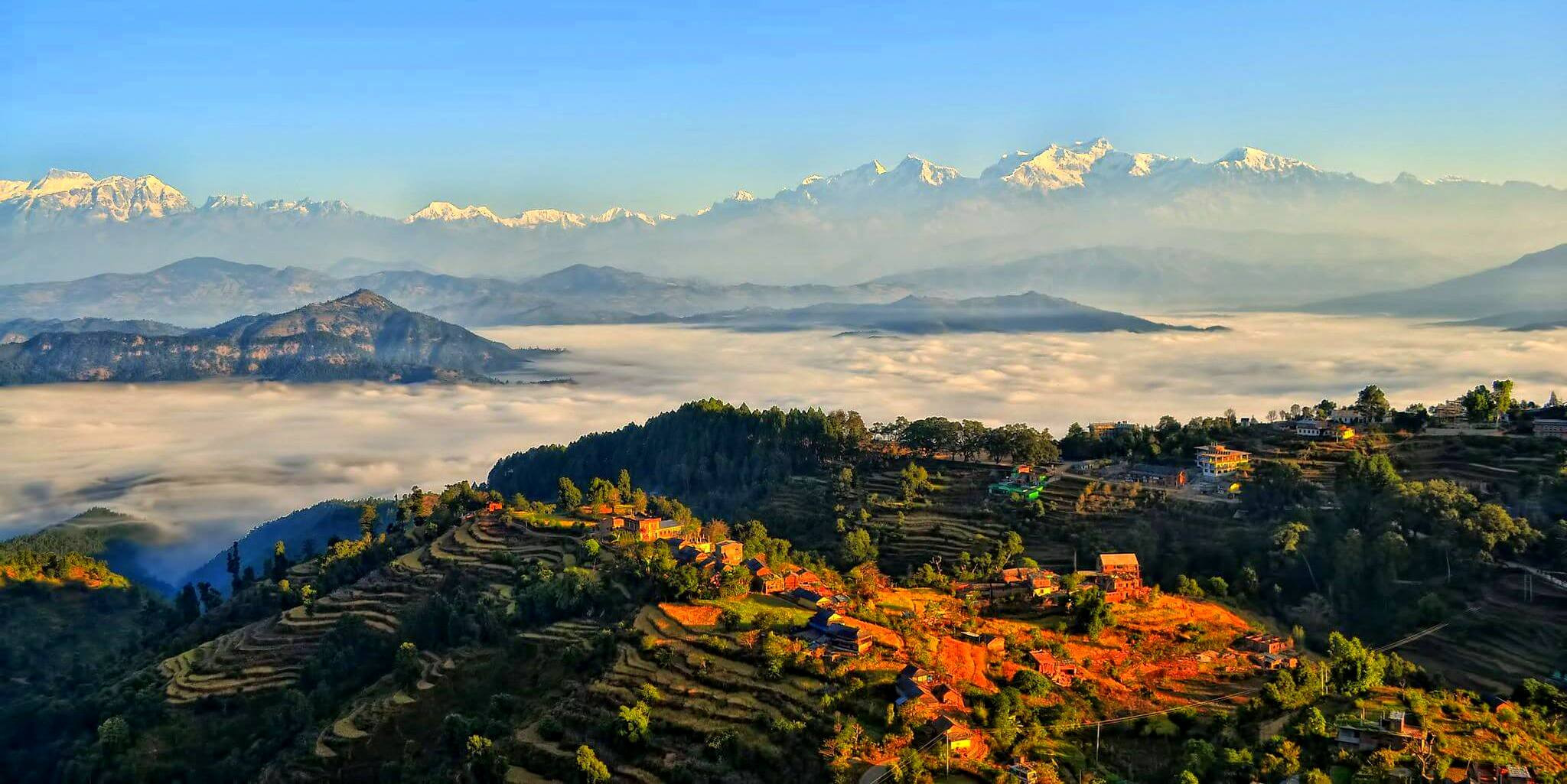Kathmandu Valley
Located in the core of Nepal, the Kathmandu Valley is not only the political and economic hub of the nation but also a cultural treasure trove that entices tourists with its vibrant traditions and deep historical value. The main sights of Kathmandu Valley are given below:
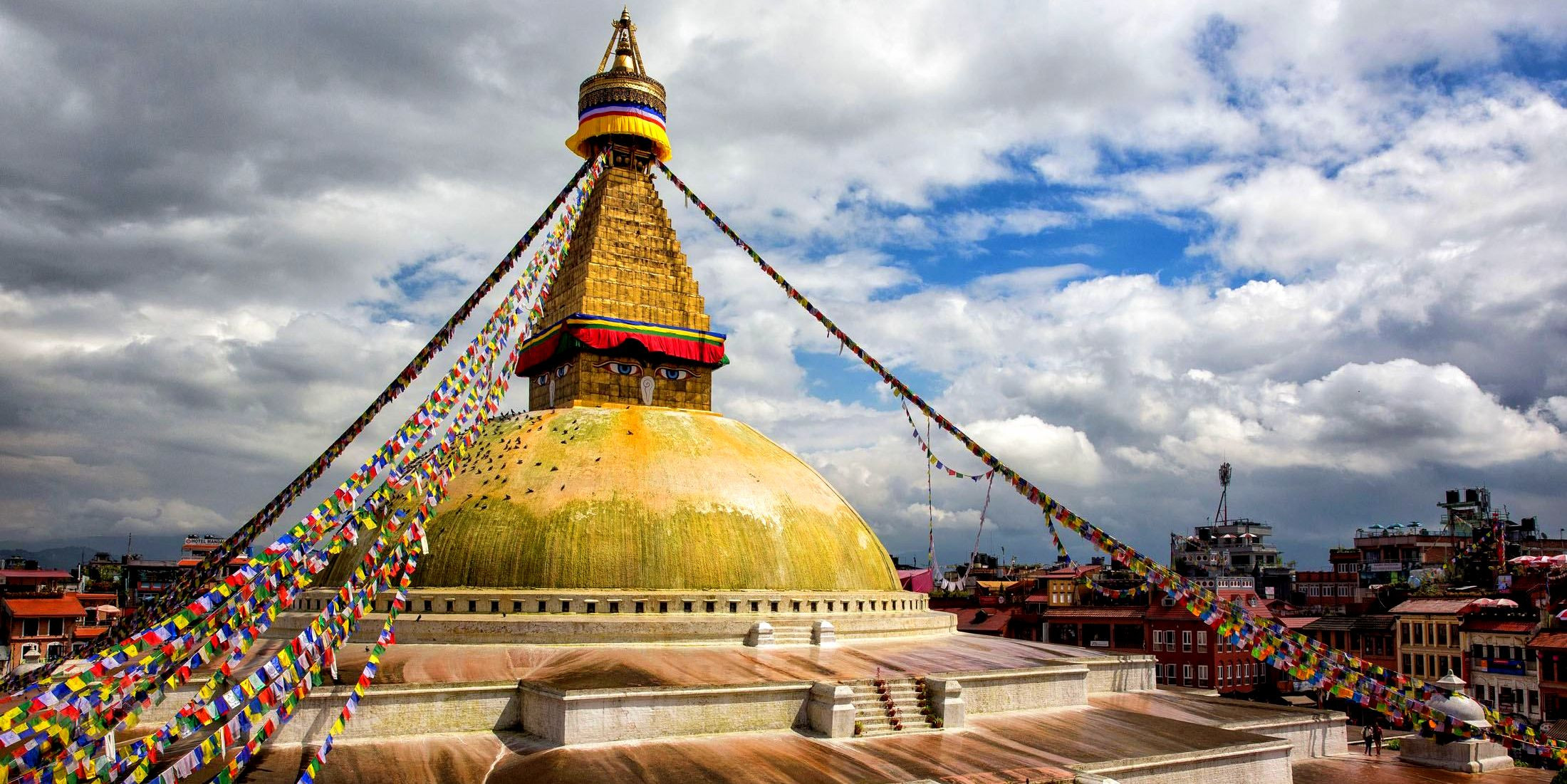
Rich Historical Legacy: Given their series of palaces, courtyards, temples, and monuments dating from the 12th to 18th centuries, the Kathmandu Valley is considered a UNESCO World Heritage site. From the Newar kings to the Shah dynasty, this site is a superb monument to the societies that have existed in this valley throughout history.
Three Durbar Squares' sites:
The valley includes three renowned Durbar Squares: Kathmandu, Patan, and Bhaktapur. Every square shows off its distinctive architectural wonders:
-
The old royal palace, many temples, and the home of the Kumari, goddess living, grace Kathmandu Durbar Square.
-
The beautiful exhibition of Newari architecture and the finely sculpted stone, metal, and wood works define Patan Durbar Square.
-
With its iconic Nyatapola Temple and well-preserved palace complexes, Bhaktapur Durbar Square stands out.
Pilgrimages to hopeless sites: The valley is spotted with many important spiritual sites, both historically and religiously. Also called the Monkey Temple, Swayambhunath provides sweeping views of the valley and is an important destination for Buddists on pilgrimage. Especially on Shivaratri, Pashupatinath Temple—one of Shiva's most holy Hindu temples—draw draws thousands of devotees every year.
Living Traditions and Customs: Living museum of Nepali culture and customs is found in Kathmandu Valley. Frequent festivals with grand ceremonies, traditional music and dancing, abound as the local Newar society honours its rich cultural heritage. Seen in the lovely artifacts, ceramic, and bustling markets are valley's custom of craftsmanship.
Art and museums: Furthermore found in the valley are many museums providing knowledge on its wealth of history and culture. Historical works of art, medieval armor, and other artifacts are shown at the National Museum of Nepal and the Patan Museum. Throughout the valley, artist galleries highlight both modern and traditional pieces, thus providing insight on the artistic range of the area.
Culinary variety is what happens when different cultures meet: With a range of flavours inspired by both Indian and Tibetan cultures, Nepali food is one more highlight of the Kathmandu Valley. Local cuisine, which includes Newari specialties, momos (dumplings), and dal bhat (lentils and rice), helps to define the place.
Connectivity and availability: Kathmandu Valley is well linked by air with the sole international airport in Nepal, therefore providing convenient access for overseas visitors. Furthermore, it is a center for more investigation of the remote regions of Nepal, including Himalayan treks.
A close examination of the Kathmandu Valley provides a deep knowledge of Nepal's history, culture, and spiritual depth, therefore making it a must-experience for everybody going to Nepal. Kathmandu Valley offers a memorable trip through the heart of Nepal whether you are strolling along the ancient alleys, celebrating a festival, or simply admiring the ornate architecture.
Pokhara
The second-most visited city in Nepal and a well-known spot for both foreign and local visitors, Pokhara is sometimes known as the "Jewel of the Himalayas". More than just a starting point for the renowned Annapurna treks, Pokhara is a peaceful haven with a great mix of natural beauty and adventure options located under the towering Annapurna Massif. For every tourist, here is why one absolutely should go Pokhara:
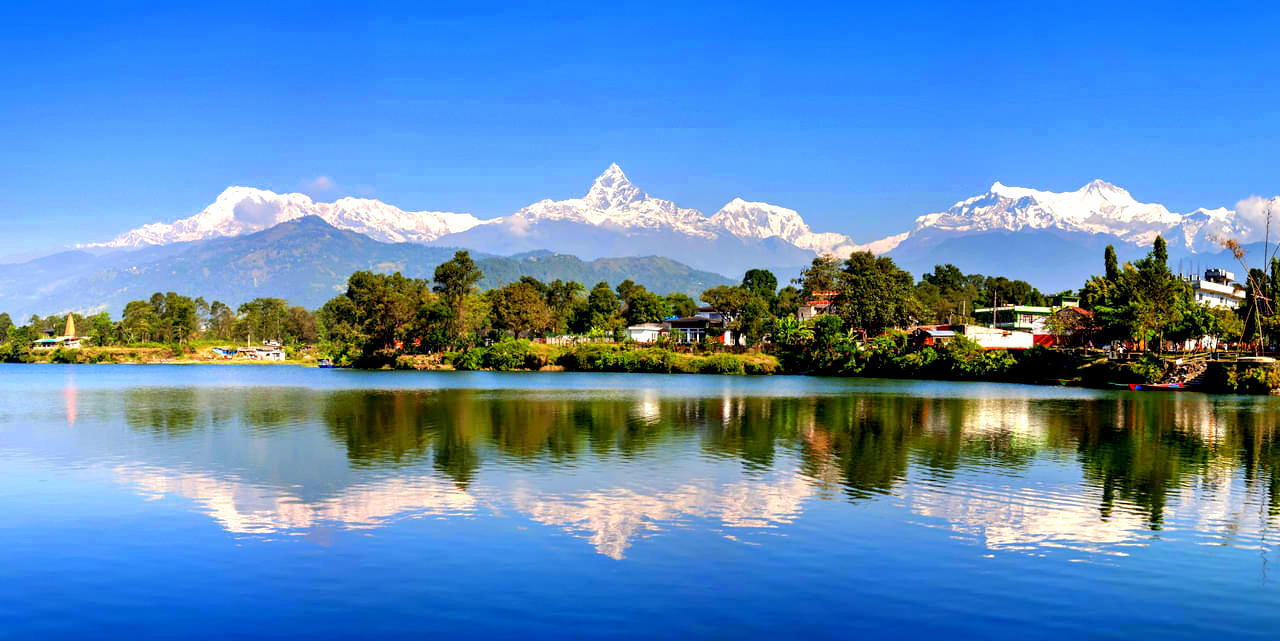
-
Breathtaking natural beauty: Pokhara is famous for its magnificent natural beauty. Alongside the lovely Phewa Lake, the city offers panoramic views of the snow-capped mountain, notably Mount Machhapuchhre (Fishtail Mountain), which reflect gorgeously on the surface of the lake. Visitors may ride boats with a panoramic perspective of the mountain ranges. Particularly enchanting are the sunrise and sunset vistas from the lakeside.
-
Adventure sports: Pokhara serves as a center of adventure sports and recreation. Exciting choices including paragliding abound and give magnificent aerial sights of the city and the adjacent hills. Other favorite pastimes are bungee jumping, ultra-light flights, and zip-lining. The Upper Seti River offers thrilling white-water rafting opportunities for water fans.
-
Hiking and Trekking: Among the most well-known treks in the world starting from Pokhara include the Annapurna Base Camp trek and the Annapurna Circuit. The city serves hikers of all abilities, from those wanting brief walks around the valley to others going on long multi-day trips across the Annapurna region. From rocky mountain passes to thick rhododendron forests, the routes present varied topography.
-
Peace pagoda and cave: From a hill above the city, the World Peace Pagoda provides a peaceful setting and breathtaking views of the whole Pokhara Valley and the Phewa Lake set against the Himalayan range. Furthermore of interest to geology aficionados and lay visitors are the Mahendra Cave and the Bat Cave, fascinating natural formations found in Pokhara.
-
Cultural attrations: Pokhara is also home to many interesting cultural sights. While the Pokhara Museum highlights the ethnic variety and history of the Western Region of Nepal, the Gurkha Museum pays homage to the well-known Gurkha troops. Important religious grounds that also provide knowledge into local religious customs include Bindhyabasini and Tal Barahi temples.
-
Culinary delicacies: As varied as its topography, the culinary scene is found in Pokhara. From authentic Tibetan momos to freshly caught fish from Phewa Lake, guests may try a mix of traditional Nepali dishes and foreign tastes. Perfect for unwinding after a day of sightseeing or hiking, the calm bars and cafés of the city complement its busy dining scene.
-
Leisure and well-being: Pokhara has many wellness retreats and spas for people seeking to relax. Quiet surroundings at yoga and meditation centers let guests renew themselves against the serene background of the Himalayas.
-
Access validity: Thanks to a brief flight or a beautiful drive through the Nepalese countryside, Pokhara is readily reached from Kathmandu, therefore it is a good spot for tourists.
Its unusual mix of magnificent beauty, exciting possibilities, and laid-back ambiance renders Pokhara a must-see destination on every Nepali itinerary. Pokhara offers every guest something if you are looking for exploration, spiritualism, or simply a place to unwind and appreciate nature.
Chitwan National Park
A UNESCO World Heritage Site since 1984, Chitwan National Park is among Nepal's top wildlife refuges located in the Terai lowlands of the nation. Known for its natural variety and lively ecosystems, Chitwan provides a genuine wildlife experience that draws nature lovers worldwide. These are the visit highlights and main attractions of Chitwan National Park:
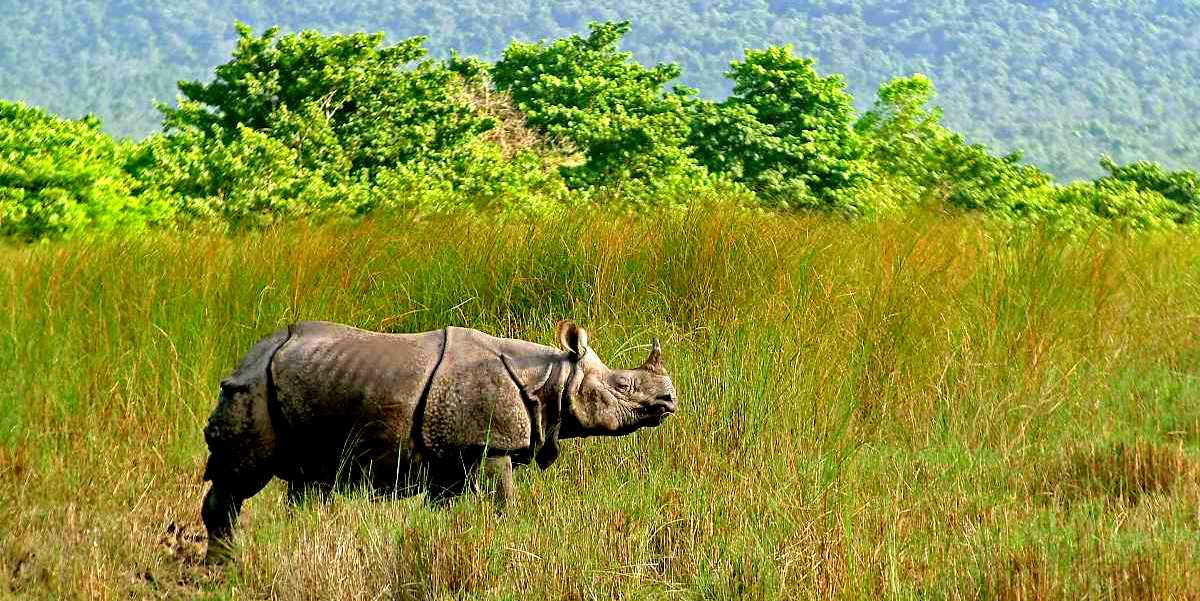
-
Rich Biodiversity: Chitwan National Park is home to an impressive array of flora and fauna. It is one of the last bastions for the endangered Bengal tiger and the one-horned rhinoceros. The park also hosts other wildlife species like leopards, sloth bears, gharial crocodiles, and over 500 species of birds, making it a birdwatcher's paradise. The diverse habitats within the park, from dense forests to grassy plains and marshy lands, support a rich variety of ecosystems.
-
Jeep Safaris: For those who prefer a more conventional safari, jeep tours are available. These guided safaris venture deeper into the park, increasing your chances of spotting a wide range of wildlife. Morning or late afternoon drives are particularly productive for seeing animals as they are more active during these cooler parts of the day.
-
Canoe Rides and Nature Walks: Canoeing along the Rapti or Narayani rivers is another tranquil way to explore Chitwan. These canoe trips provide a closer look at aquatic life and a chance to see crocodiles and water birds along the banks. Guided nature walks, meanwhile, offer insights into the smaller inhabitants of the park and the chance to learn about the local flora.
-
Cultural Experiences: Visiting Chitwan also presents an opportunity to engage with the local Tharu community. The Tharus have lived in and around the park for centuries and have a unique culture that has adapted to the challenges of living amidst abundant wildlife. Cultural shows, village tours, and traditional meals offer a glimpse into their rich heritage and lifestyle.
-
Conservation Efforts: Chitwan is at the forefront of conservation efforts in Nepal, with successful programs for rhino and tiger conservation. The park's efforts have helped stabilize and increase the populations of these critical species. Visitors contribute to these efforts indirectly through park fees and directly by participating in educational tours focusing on conservation.
-
Accessibility and Accommodations: Chitwan National Park is easily accessible from Kathmandu and Pokhara by road and local flights, making it a convenient addition to any Nepali travel itinerary. The area around the park offers a range of accommodations, from luxury lodges to budget guesthouses, catering to all preferences and budgets.
Visiting Chitwan National Park provides not only a chance to witness Nepal’s wildlife but also to experience the thrill of adventure and gain insights into conservation efforts in one of the world's biodiversity hotspots. It's an essential stop for anyone interested in nature and wildlife in Nepal.
Lumbini
Lumbini, located in the Rupandehi District of Nepal's Terai plains, is revered as the birthplace of Siddhartha Gautama, the historical Buddha, making it one of the most significant pilgrimage sites in the Buddhist world. Designated as a UNESCO World Heritage Site, Lumbini attracts thousands of pilgrims and visitors each year who come to soak in the peace and spirituality of this sacred ground. Here are the key aspects and highlights of visiting Lumbini:
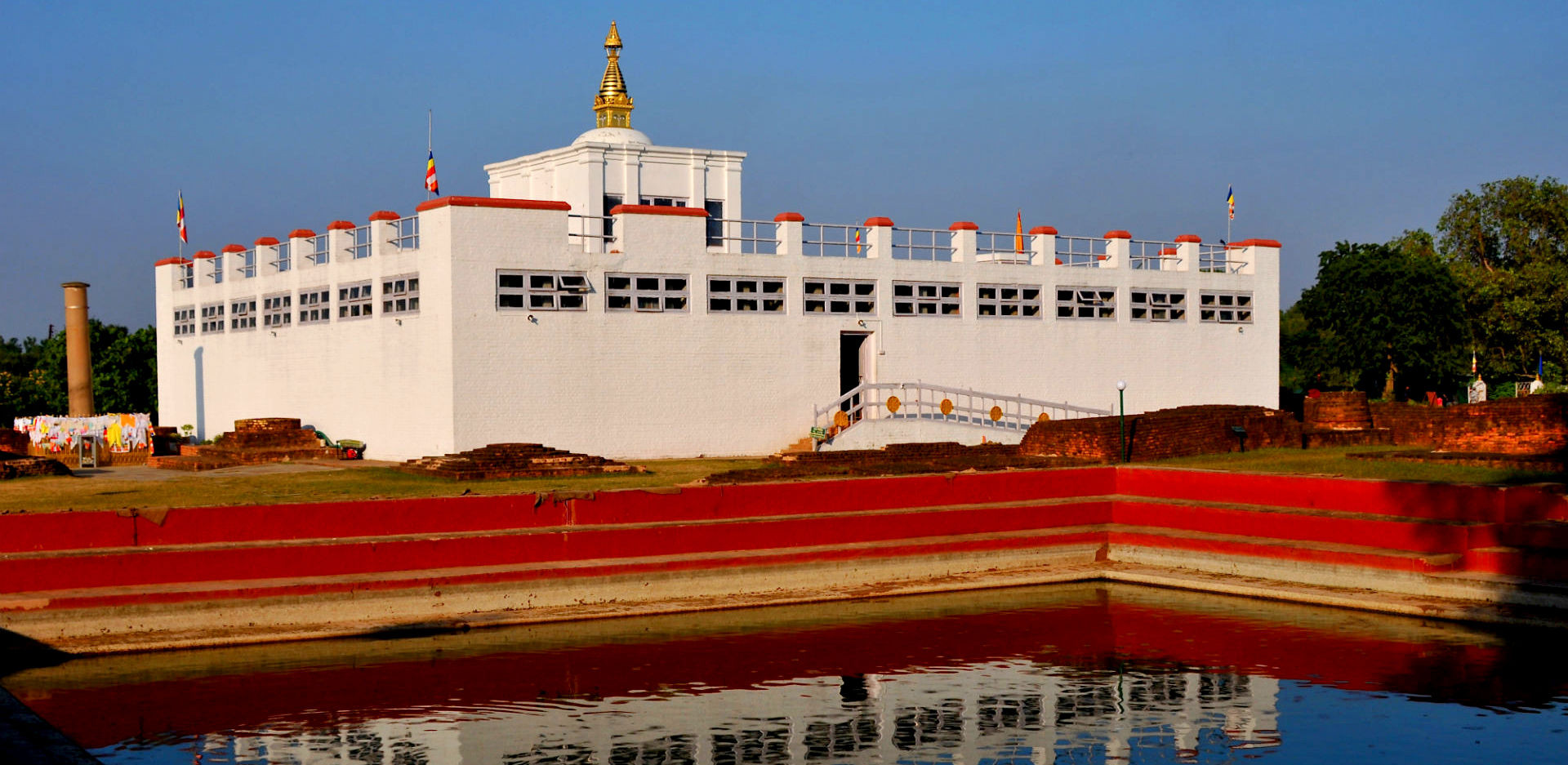
-
Birthplace of Buddha: The focal point of Lumbini is the Maya Devi Temple, which marks the precise spot where Queen Maya Devi gave birth to Siddhartha Gautama. The temple complex includes ancient ruins, the sacred Bodhi tree, and a sacred pond — Puskarni — where it's believed Maya Devi took a bath before giving birth.
-
Monuments and Temples: Lumbini has been developed into a large park known as the Lumbini Development Zone, which encompasses a wide array of monasteries built by Buddhist communities from various countries, reflecting the universal significance of the Buddha's message. These include the Chinese Monastery, the Korean Temple, and the Royal Thai Buddhist Monastery, each designed in the distinctive architectural style of their respective countries.
-
Peace Pagoda: Among the many structures, the World Peace Pagoda, built by the Japanese, stands out as a symbol of peace and unity. This white pagoda is an impressive sight and adds to the serene atmosphere of Lumbini.
-
Lumbini Museum: The Lumbini Museum houses artifacts from the Mauryan and Kushana periods, Buddhist manuscripts, and terracotta fragments. Another point of interest is the Lumbini International Research Institute, which provides resources for the study of Buddhism and promotes scholarly research.
-
Archaeological Significance: Recent archaeological discoveries beneath the Maya Devi Temple suggest that Lumbini was a center of Buddhist activity from as early as the 6th century BCE. These findings have helped scholars trace more accurately the historical timeline of Buddhist developments.
-
Pilgrimage and Festivals: Lumbini is not only a place for quiet contemplation but also a vibrant center of pilgrimage. The annual Buddha Jayanti, celebrating the birth, enlightenment, and death of Buddha, sees thousands of pilgrims gathering here to chant prayers and light lamps.
-
Environmental and Architectural Planning: The master plan for Lumbini, designed by the famed architect Kenzo Tange, ensures the preservation of the sacred area while allowing for modern amenities and infrastructure. This plan includes zones for monastic communities, pilgrimage activities, and tourist services, blending spiritual and cultural exploration with visitor comfort.
-
Accessibility: Lumbini is accessible via a short drive from Bhairahawa, which is set to open an international airport soon, enhancing international connectivity. Currently, visitors often travel to Lumbini via road from Kathmandu or Pokhara, integrating it into a broader Nepali tour.
Lumbini offers a profound experience that goes beyond religion and historical interest. It is a place that encourages reflection on the values of peace, compassion, and wisdom that the Buddha espoused, set against a backdrop of remarkable global unity in spiritual devotion. Whether you are a pilgrim, a history enthusiast, or a casual visitor, Lumbini provides a deeply enriching and tranquil experience.
Annapurna Region
The Annapurna Region in Nepal is one of the most renowned and spectacular trekking areas in the world. With its array of stunning peaks, diverse landscapes, and vibrant cultures, the region attracts thousands of trekkers each year. Here are the highlights and key aspects of visiting the Annapurna Region:
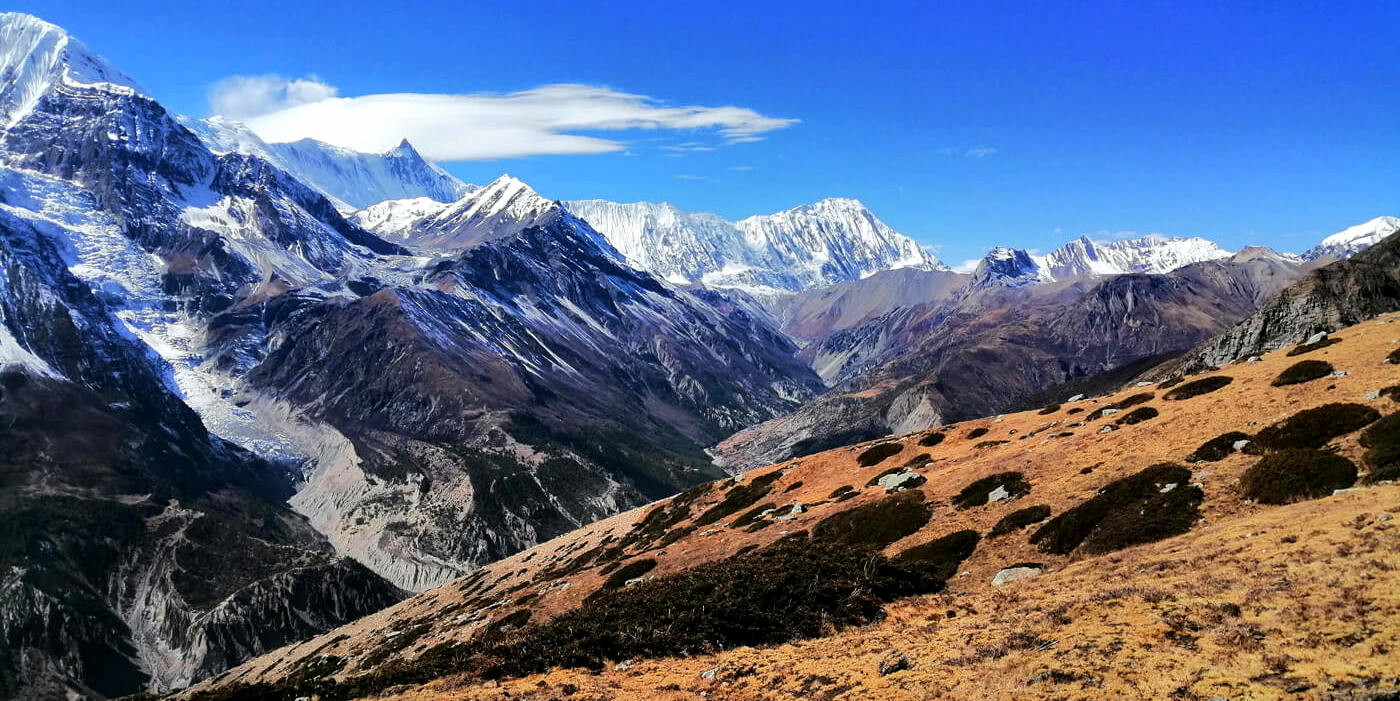
-
Diverse Trekking Routes: The Annapurna Region offers a variety of trekking routes that cater to all levels of experience and fitness. The most famous trek is the Annapurna Circuit, which takes trekkers around the entire Annapurna massif, offering an incredibly diverse range of landscapes and cultural experiences. The Annapurna Base Camp trek is shorter but equally spectacular, focusing on the south side of the Annapurna range and providing dramatic close-up views of the peaks.
-
Stunning Scenery: The region is known for its breathtaking scenery that includes high mountain passes, deep valleys, lush rhododendron forests, and arid plateaus. The trekking routes offer panoramic views of the Annapurna range, Dhaulagiri, Machhapuchhre (Fishtail Mountain), and Manaslu, among others. The diverse ecosystems and altitudes found here make each day's trek uniquely beautiful and challenging.
-
Cultural Diversity: Trekking in the Annapurna Region is not only an outdoor adventure but also a cultural journey. The trails traverse areas inhabited by various ethnic groups, including the Gurungs, Manangis, and Thakalis, offering trekkers a chance to experience their rich cultural heritage, traditional architecture, and festivals. The region is also famous for its hospitality and the warm welcome provided by the local tea houses and lodges.
-
Conservation and Sustainable Tourism: The Annapurna Conservation Area Project (ACAP) was established in 1986 as Nepal’s first and largest conservation area. It spans 7,629 square kilometers and is a model for sustainable tourism in Nepal. The project focuses on integrating environmental conservation with sustainable community development, and trekkers contribute to this through their permits and fees.
-
Unique Flora and Fauna: The region's varied climate and topography support a wide variety of flora and fauna. Trekkers can see everything from pine and bamboo forests to alpine meadows. Wildlife includes species such as snow leopards, Himalayan Tahr, and several bird species like the pheasant and the Himalayan griffon.
-
Spiritual Sites: The Annapurna Region is also spiritually significant, with several ancient temples and monasteries along the trails. The Muktinath Temple in the Mustang district is a famous pilgrimage site for both Hindus and Buddhists. It symbolizes the religious syncretism that is characteristic of Nepal.
-
Accessibility: The region is accessible via road and air, with the city of Pokhara serving as the gateway for most treks in the Annapurna area. Pokhara is well-connected to Kathmandu and offers various services, including gear rental, guides, and trekking information.
-
Seasonal Considerations: The best times to trek in the Annapurna Region are during the spring (March to May) and autumn (September to November) seasons when the weather is clear and dry, and the visibility of the mountains is at its best.
Trekking in the Annapurna Region is an unforgettable experience that combines natural beauty, cultural richness, and adventure. It's an excellent destination for those looking to explore the Himalayas, whether you're a seasoned trekker or a beginner looking for your first Himalayan adventure.
Everest Base Camp
Trekking to the Everest Base Camp is one of the most iconic adventures in the world, offering an unparalleled journey into the heart of the Himalayas. This trek not only presents the awe-inspiring majesty of Mount Everest but also immerses trekkers in the vibrant culture of the Sherpa people. Here’s what makes the Everest Base Camp trek a must-do for adventure enthusiasts:
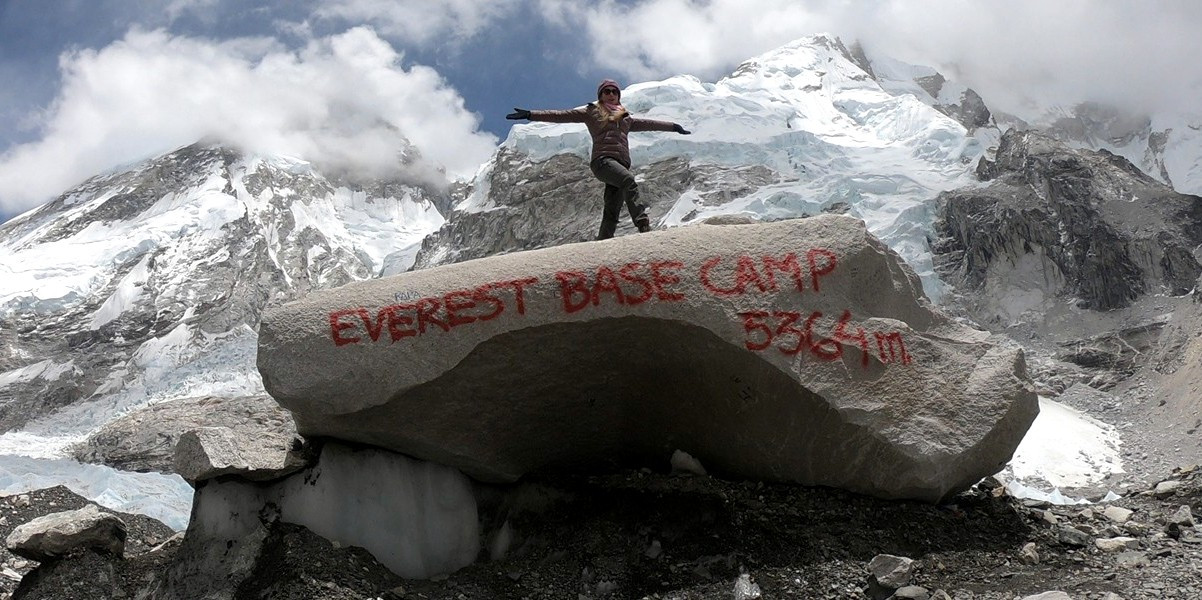
-
Spectacular Scenery: The trek to Everest Base Camp is renowned for its breathtaking vistas. From the flight into Lukla, one of the world’s most dangerous airports, to the path leading to the base of the highest peak on Earth, trekkers are treated to stunning views of towering mountains, including several of the world’s highest such as Lhotse, Nuptse, and of course, Everest itself. The landscape varies from lush rhododendron forests at lower altitudes to stark, glacier-filled valleys at higher elevations.
-
Cultural Experience: The trek provides a deep dive into the culture of the Khumbu region’s indigenous people, the Sherpas, known globally for their mountaineering prowess. Trekkers can visit monasteries, museums, and partake in local festivities that may occur during their visit. The Tengboche Monastery, one of the largest in Khumbu, is a significant highlight, where trekkers can observe Buddhist rituals and soak in the spiritual ambiance.
-
Challenging Trek: The trek to Everest Base Camp is not just a physical challenge but also an emotional and spiritual journey. Covering roughly 130 km round trip, it demands good physical fitness and acclimatization to altitudes exceeding 5,000 meters (16,404 feet). The sense of accomplishment upon reaching the Base Camp at 5,364 meters (17,598 feet) is profound, as is the camaraderie among fellow trekkers and local guides.
-
Rich Biodiversity: As part of the Sagarmatha National Park, a UNESCO World Heritage site, the region boasts a rich array of biodiversity. Trekkers can encounter unique wildlife such as the Himalayan tahr, musk deer, and the elusive snow leopard, as well as a variety of bird species like the Impeyan pheasant, also known as the Danphe, Nepal’s national bird.
-
Sustainability and Conservation: The trek also educates visitors on the importance of sustainability in such fragile ecosystems. Efforts are continuously made to ensure that tourism impacts are minimized through waste management strategies and the use of renewable energy sources by many of the teahouses along the route.
-
Logistics and Preparation: Treks typically start from Lukla, following a flight from Kathmandu. The route passes through famous Sherpa villages such as Namche Bazaar – the gateway to the high Himalayas, Dingboche, and Gorakshep before reaching the base camp. Accommodations on the trail are in the form of teahouses that provide basic lodging and meals, which helps support the local economy.
The Everest Base Camp trek is more than just a hike; it's an expedition into the heart of one of the world's most awe-inspiring landscapes, filled with challenges and rewards. It’s a pilgrimage to the base of the world’s highest peak, offering an unforgettable adventure that draws trekkers back time and time again.
Bhaktapur
Bhaktapur, also known as "Bhadgaon" or "Khwopa" in the local Newar language, is a historic city located in the Kathmandu Valley of Nepal. Renowned for its rich cultural heritage, ancient architecture, and thriving traditional crafts, Bhaktapur is part of the UNESCO World Heritage site along with Kathmandu and Patan. This city offers a glimpse into a past world with its well-preserved palaces, temples, and squares. Here are the highlights of Bhaktapur:
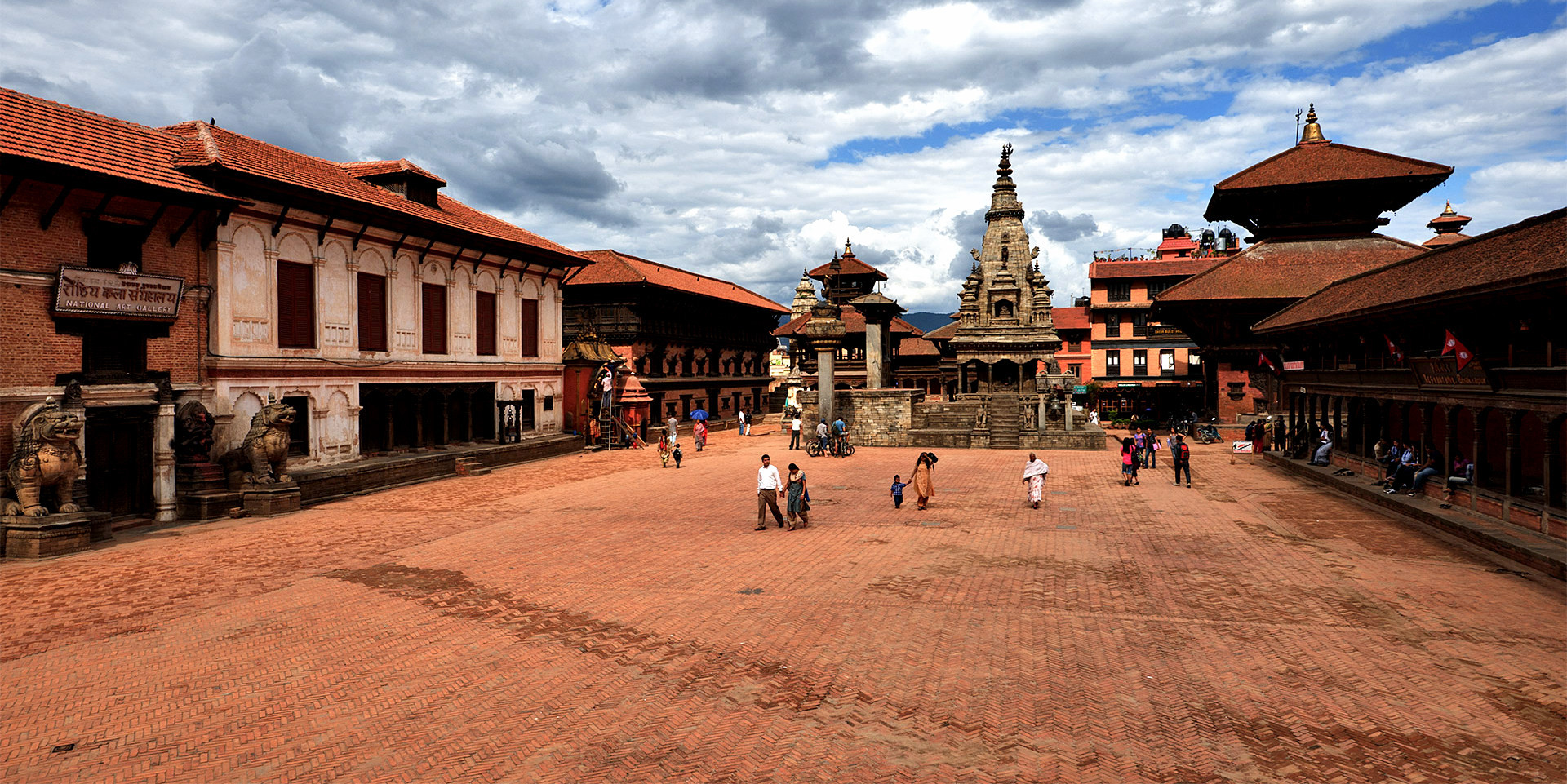
-
Architectural Grandeur: Bhaktapur is famous for its medieval art and architecture. The heart of the city is the Bhaktapur Durbar Square, which features a collection of pagoda and shikhara-style temples, intricately carved windows, and stone artworks. Notable structures include the 55-Window Palace, which serves as a museum and showcases relics of its rich historical past, and the Nyatapola Temple, the tallest temple in Nepal, known for its massive structure and steep stone steps.
-
Living Heritage: Unlike other cities that have modernized rapidly, Bhaktapur retains much of its ancient character. It's like stepping back in time. The city's inhabitants continue to engage in traditional crafts such as pottery, woodcarving, and weaving. Walking through the streets, visitors can see artisans at work, particularly in Pottery Square, where clay pots are skillfully handcrafted and set out to dry in the sun.
-
Cultural Festivals: Bhaktapur is vibrant with festivals and traditions. The Bisket Jatra, an annual festival held in the Nepali New Year, is one of the most spectacular. It involves a giant chariot procession carrying images of gods and goddesses, tug-of-war between locals, and various cultural performances. Another significant event is the Gai Jatra festival, which honors those who have passed away in the last year.
-
Local Cuisine: The city is also known for its unique culinary offerings, particularly the king curd (Juju Dhau), a creamy yogurt that is a must-try for anyone visiting. Made with buffalo milk and traditionally set in clay pots, its flavor and texture are a treat.
-
Artistic Expressions: Bhaktapur is also a center for Nepali culture, music, and dance. Traditional Newari music and dance performances are common during festivals, providing visitors with an insight into the rich cultural fabric of this ancient city.
-
Peaceful Environment: One of the most appealing aspects of Bhaktapur is its pedestrian-friendly environment. The city has limited access to motor vehicles, which preserves its tranquility and allows visitors to leisurely explore the streets without the noise and pollution typical of more urban areas.
-
Accessibility: Bhaktapur is conveniently located just about 13 kilometers (8 miles) east of Kathmandu, making it easily accessible for a day trip or a longer stay to fully immerse in its ancient atmosphere.
Visiting Bhaktapur provides not only a deep dive into Nepal's architectural and cultural history but also offers a peaceful and enriching experience away from the hustle and bustle of modern life. Its well-preserved environment and commitment to tradition make it a unique gem in Nepal's crown.
Patan
Patan, also known as Lalitpur (City of Beauty), is one of the three major cities in the Kathmandu Valley. Often overshadowed by its larger neighbor, Kathmandu, Patan is renowned for its artisan community and rich cultural heritage, making it a captivating destination for visitors interested in the arts and history.
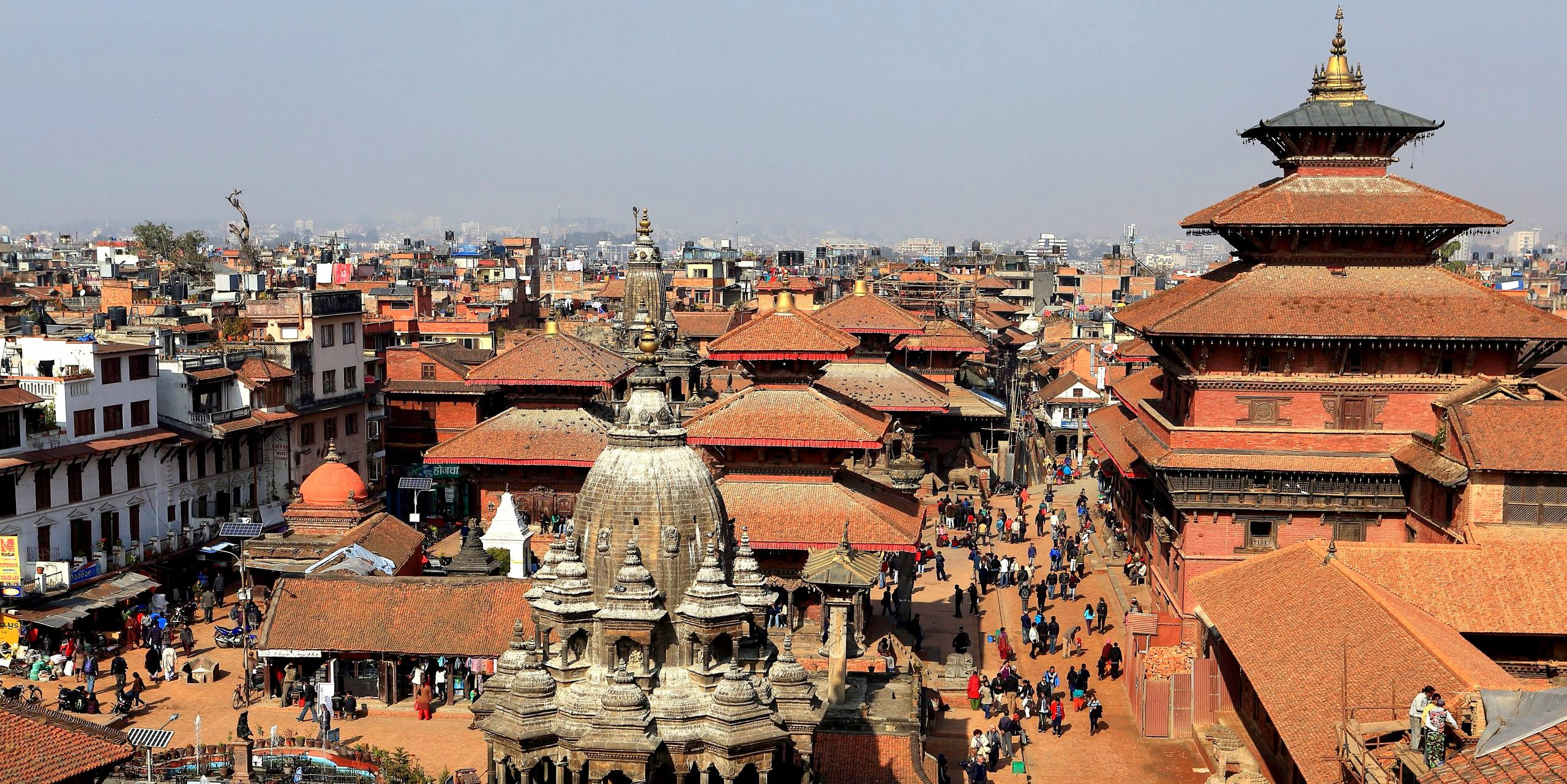
-
Patan Durbar Square: At the heart of Patan lies the Patan Durbar Square, a UNESCO World Heritage Site renowned for its display of Newari architecture. This square is lined with temples and royal buildings, notable for their intricate carvings and beautiful courtyards. The former royal palace now houses the Patan Museum, which exhibits an exceptional collection of Nepalese art, including statues, thangkas, and other artifacts that reflect the city’s rich historical and cultural tapestry.
-
Art and Craftsmanship: Patan is the epicenter of fine art in Nepal, particularly known for its metalworking and woodcarving artisans. The city's backstreets are dotted with workshops where craftspeople continue to use age-old techniques to create exquisite sculptures, jewelry, and traditional utensils. This dedication to craft is also evident in the beautifully carved wooden windows and balconies adorning the city’s buildings.
-
Golden Temple (Hiranya Varna Mahavihar): A few minutes’ walk north of the Durbar Square is the Golden Temple, a stunning monastery adorned with gold. This Buddhist monastery, built in the 12th century, is an exquisite example of Newar architecture. Its entrance guarded by stone lions and its roofs upheld by wooden struts carved into figures of gods and goddesses, the Golden Temple is a must-visit for its peaceful atmosphere and artistic splendor.
-
Mahaboudha Temple: Another remarkable landmark in Patan is the Mahaboudha Temple, which is styled after the famous Mahabodhi Temple in Bodh Gaya, India. Made of clay bricks engraved with thousands of Buddha images, this temple is a testament to the city’s Buddhist heritage and its skilled artisans. It's a superb example of terra-cotta artistry that dates back to the 16th century.
-
Kumbeshwar Temple: One of the oldest temples in Patan, Kumbeshwar Temple, is dedicated to Lord Shiva. It features a five-story structure, one of the few of its height in the Kathmandu Valley, complete with a fine woodcarved balcony and struts. The temple complex also includes two ponds, which are especially lively during the Janai Purnima festival when devotees come to bathe.
-
Traditional Festivals: Patan's cultural life is vibrant with traditional festivals such as the Patan Jatra, a chariot festival similar to those in Kathmandu and Bhaktapur but unique in its celebration and scale. The Rato Machhindranath Jatra, in particular, is the longest and most significant festival in Patan, celebrated by both Hindus and Buddhists.
-
Accessibility: Patan is conveniently accessible from Kathmandu, with a short drive or even a walk across a bridge separating the cities. This proximity makes it easy for visitors to spend a day or even a few hours exploring the rich culture and history of Patan.
Patan is not just a city of beautiful artifacts; it's a living museum where visitors can experience the continuity of history and the endurance of traditional art forms. Whether you're an art lover, a history buff, or simply a curious traveler, Patan offers a profound and enriching experience that highlights the best of Nepalese culture and heritage.
Tips for Most Visited Places in Nepal
When visiting the most popular destinations in Nepal, a few tips can enhance your experience and ensure a smooth and enjoyable trip. Here are some practical tips for exploring the top attractions in Nepal:
Prepare for the Weather
-
Layer Up: Weather in Nepal can be quite variable, especially in mountainous areas. Layering allows you to adapt to changing conditions. Always carry a waterproof jacket and warm clothing, especially if you are trekking.
-
Sun Protection: At high altitudes, the sun can be particularly harsh. Use sunscreen, wear a wide-brimmed hat, and use sunglasses to protect against UV rays.
Respect Local Culture
-
Dress Modestly: When visiting temples or religious sites, dress conservatively. Cover shoulders and knees as a sign of respect.
-
Ask Before Photographing: Always ask for permission before taking photos of local people or religious ceremonies.
- Learn Basic Nepali Phrases: Greetings and simple phrases in Nepali can go a long way in showing respect and appreciation for the local culture.
Health and Safety
-
Stay Hydrated: Drink plenty of water, especially while trekking, to avoid dehydration.
-
Acclimatize Properly: When trekking in high altitudes, like in the Annapurna or Everest regions, take time to acclimatize to avoid altitude sickness.
-
Travel Insurance: Make sure you have travel insurance that covers high-altitude trekking and medical evacuation.
Plan Your Visits
-
Best Times to Visit: The best times to visit most places in Nepal are during the spring (March to May) and autumn (September to November) when the weather is clear and dry.
-
Book in Advance: For popular trekking routes and during peak tourist seasons, book your accommodations and guides in advance.
- Check Local Festivals: Aligning your visit with local festivals can provide deeper insights into Nepali culture and festivities.
Responsible Tourism
-
Support Local Businesses: Choose local and family-run businesses for accommodations, meals, and guides to help support the local economy.
-
Environmentally Conscious: Be mindful of your environmental impact. Dispose of waste properly and use water sparingly.
- Cultural Sensitivity: Be respectful of local customs and traditions. Small gestures like removing shoes before entering a home or temple are appreciated.
Stay Connected
-
Local SIM Card: Purchase a local SIM card for easier communication and access to services like maps and emergency contacts.
-
Inform Someone of Your Itinerary: Especially if trekking, always let someone know your route and expected return time.
Emergency Preparedness
-
Know Important Contacts: Keep a list of emergency contacts, including local authorities, your embassy, and emergency services.
-
First Aid Kit: Carry a basic first aid kit for minor injuries, especially if you are trekking.
Following these tips can make your visit to Nepal more enjoyable and safe, allowing you to fully embrace the rich experiences that the country has to offer.
Best Time for Most Visited Places in Nepal
Choosing the best time to visit Nepal largely depends on the activities you plan to engage in and the regions you wish to explore. The country experiences four main seasons: spring, summer (monsoon), autumn, and winter, each offering different attractions and challenges.
Spring (March to May)
-
Ideal for Trekking: Spring is one of the best times for trekking as the weather is mild, and the trails are dry. This is also an excellent time for climbing expeditions.
-
Blooming Flora: The hillsides and lower mountains bloom with rhododendrons and other wildflowers, making it a beautiful time for nature lovers.
-
Wildlife Viewing: In places like Chitwan National Park, the end of spring can be a great time to see wildlife as the vegetation starts to thin out, making animals easier to spot.
Summer/Monsoon (June to August)
-
Less Crowded: This is the off-peak season due to the rain, making popular spots less crowded. Accommodations are often cheaper during this time.
-
Lush Landscapes: The monsoon rains bring lush greenery to the valleys and hills, which can be incredibly picturesque.
-
Challenges: Trekking can be more challenging due to slippery trails and leeches. Visibility is also reduced, and mountain views are often obscured by clouds.
Autumn (September to November)
-
Peak Trekking Season: Autumn is the most popular time to visit Nepal for trekking. The post-monsoon climate provides clear skies, excellent visibility, and moderate temperatures.
-
Festivals: Major Nepali festivals like Dashain and Tihar occur in autumn, offering visitors a chance to experience Nepali culture at its most vibrant.
-
High Altitude Treks: Ideal conditions for high-altitude treks like Everest Base Camp and the Annapurna Circuit, with stable weather and little rainfall.
Winter (December to February)
-
Clear Skies: In lower altitude areas, winter can be a great time to visit due to the clear skies and fewer tourists.
-
Cold Conditions: Higher altitude regions can be extremely cold, and some high passes may be closed due to snow.
-
Ideal for Cultural Tours: Cities like Kathmandu and Pokhara are cooler and less dusty, making it comfortable for sightseeing and cultural tours.
Recommendations
-
Cultural Sightseeing: Late autumn to early spring (October to April) is ideal for visiting cultural sites in Kathmandu, Pokhara, and Lumbini when the weather is mild and visibility is good.
-
Wildlife Safaris: The best wildlife viewing in Chitwan and Bardia National Parks is from late winter to early spring (February to April) when the weather is dry and animals frequently visit watering holes.
-
Trekking: Aim for either spring or autumn for the best trekking conditions. These seasons provide the clearest skies and most temperate weather, ideal for mountain treks.
Ultimately, the best time to visit Nepal will align with your specific interests and the experiences you wish to have, whether they're centered around natural beauty, cultural immersion, or adventure activities.
Nepal offers a unique blend of breathtaking landscapes, rich cultural heritage, and diverse experiences. From the historic allure of Kathmandu and the serene landscapes of Pokhara to the adventurous paths of the Annapurna and Everest regions, and the spiritual serenity of Lumbini, each destination provides a profound journey through the country's history, nature, and culture. Whether you're drawn to the thrill of a safari in Chitwan National Park, the artisan charm of Patan, or the spiritual calm of Buddha's birthplace, Nepal's most visited places promise unforgettable experiences. This beautiful country invites travelers to explore its wonders, where every view astonishes and every moment becomes a cherished memory.
FAQs for Most Visited Places in Nepal
Q: What is the best time to visit Nepal for trekking?
A: The optimal periods for trekking in Nepal are during the spring (March to May) and autumn (September to November). These seasons feature clear skies, stable weather, and excellent visibility, ideal for high-altitude treks.
Q: Do I need a visa to visit Nepal?
A: Most foreign nationals require a visa to enter Nepal. Tourist visas are available on arrival at Tribhuvan International Airport in Kathmandu and at some land borders, or they can be applied for in advance through Nepali embassies or consulates.
Q: What are some must-visit cultural sites in Kathmandu?
A: Essential cultural sites in Kathmandu include Kathmandu Durbar Square, Swayambhunath Stupa (Monkey Temple), Pashupatinath Temple, and Boudhanath Stupa.
Q: Is it safe to travel to Nepal?
A: Nepal is generally safe for travelers. However, it's wise to take usual travel precautions, stay informed about local conditions, particularly in trekking areas, and adhere to guidelines for preventing altitude sickness.
Q: How should I prepare for altitude sickness?
A: Prevent altitude sickness by ascending gradually, acclimatizing properly, staying hydrated, and avoiding alcohol and tobacco. Consider carrying altitude sickness medication as prescribed by a doctor.
Q: What should I pack for a trek in the Annapurna or Everest regions?
A: Pack sturdy hiking boots, thermal and waterproof clothing, a first aid kit, a sleeping bag for low temperatures, sun protection, and a trekking map. Hiring a guide or porter is also advisable.
Q: How can I respect local customs and traditions while visiting Nepal?
A: Dress modestly, especially at religious sites. Always seek permission before taking photos of people or religious events. Learning basic Nepali phrases can show respect and appreciation for the culture.
Q: Can I use my credit cards in Nepal?
A: Credit cards are accepted in hotels, restaurants, and some shops in major cities and tourist areas. However, carry cash for use in smaller towns or while trekking, where ATMs might not be available.
Q: What are the wildlife viewing opportunities in Nepal?
A: Chitwan National Park and Bardia National Park offer excellent wildlife viewing, including rhinos, tigers, elephants, and various bird species on jeep safaris or guided jungle walks.
Q: Are there health concerns I should be aware of before traveling to Nepal?
A: Consult a healthcare provider for recommended vaccinations and health precautions for Nepal. Also, consider health insurance that covers high-altitude trekking and medical evacuation.
For the Nepal tour, please click here.
If you are looking for different kinds of Nepal Tours or Trekking Packages, feel free to contact us.
